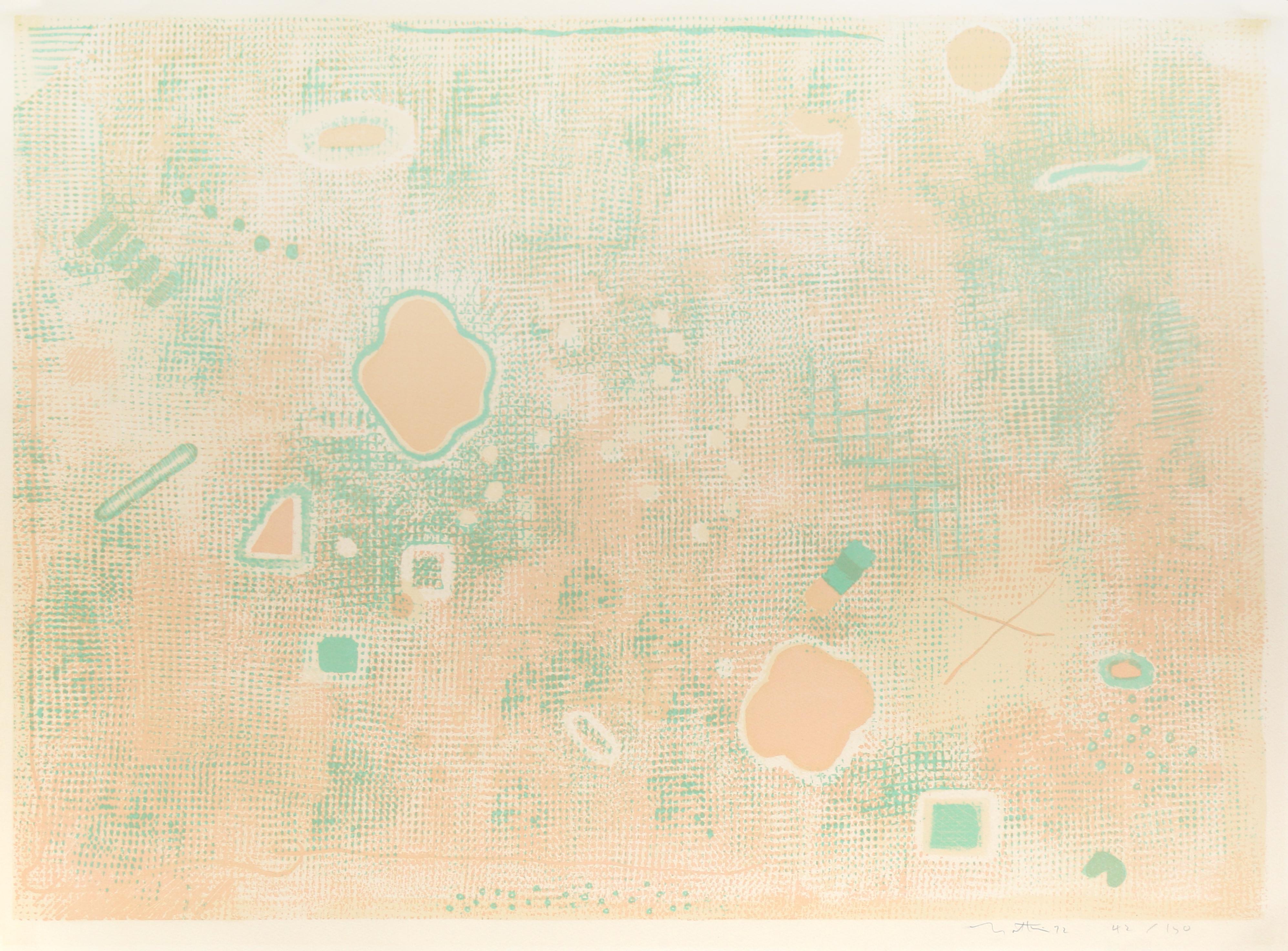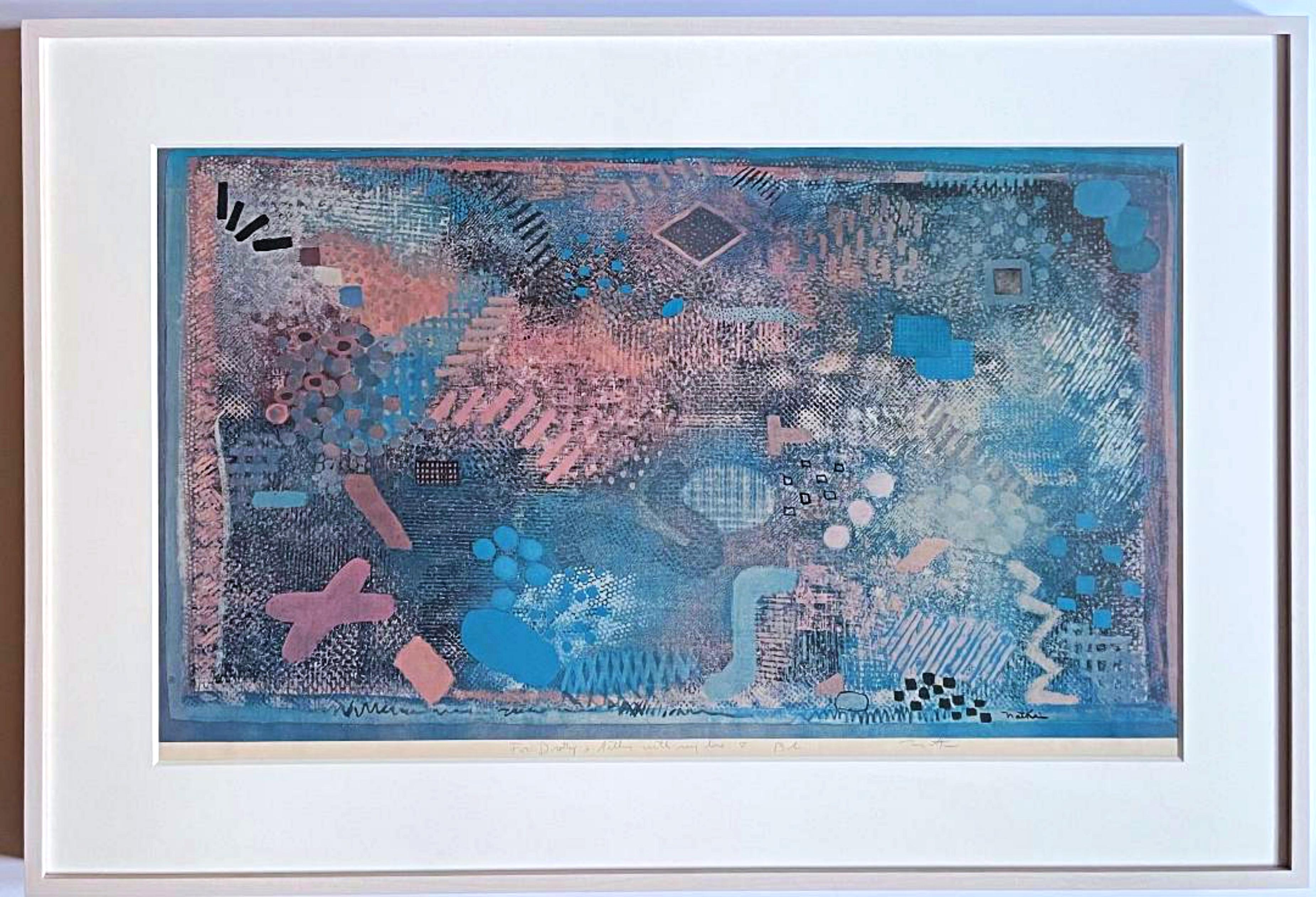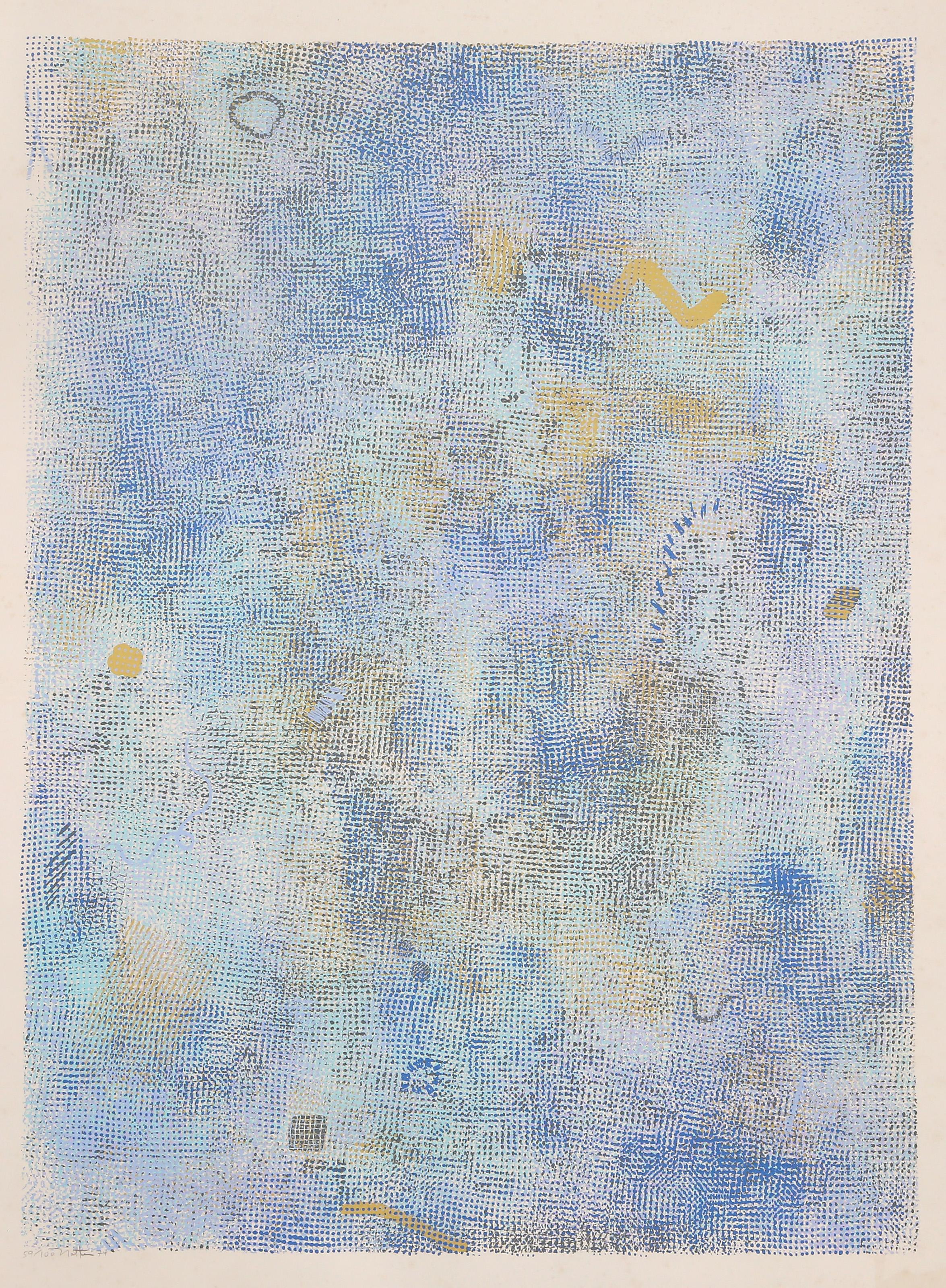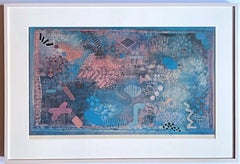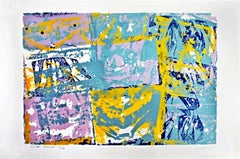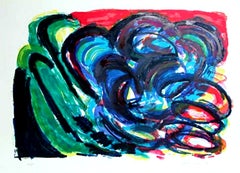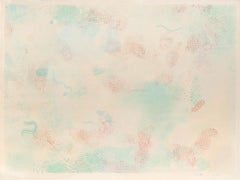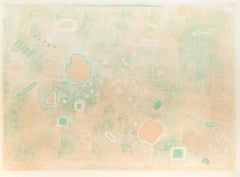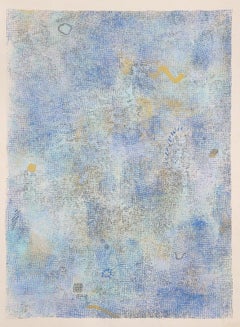Items Similar to Robert Natkin, Intimate Lighting (Pink) Signed Abstract Expressionist silkscreen
Want more images or videos?
Request additional images or videos from the seller
1 of 9
Robert NatkinRobert Natkin, Intimate Lighting (Pink) Signed Abstract Expressionist silkscreen1974
1974
$2,000
£1,555.21
€1,768.29
CA$2,881.43
A$3,150.47
CHF 1,647.10
MX$37,899.61
NOK 20,842.39
SEK 19,548.33
DKK 13,203.62
About the Item
Robert Natkin
Intimate Lighting, 1974
Silkscreen on Arches paper
27 × 38 inches
Pencil signed, dated and numbered from the limited edition of 150 on the front
Published by Chromacomp, Inc.
Provenance: Acquired from the personal collection of Jackson and Eunice Lowell, founders of Chromacomp, Inc.
Unframed
This stunning large screenprint was created in the 1970s by the renowned Abstract Expressionist painter Robert Natkin. Natkin has the distinction of being the first living artist to have received a one million commission, the highest amount ever paid at the time, for a painting. This painting still graces the front lobby of the Newscorp headquarters at 1211 Avenue of the Americas in New York City. This print has never been framed and has generous white margins with deckled edges. It was acquired directly from Chromacomp Corp, the premier international printing studio based in New York, which did most of Natkin's prints in the 1970s. Chromacomp also created prints for many other renowned artists of the era.
- Creator:Robert Natkin (1930-2010, American)
- Creation Year:1974
- Dimensions:Height: 27 in (68.58 cm)Width: 38 in (96.52 cm)
- Medium:
- Movement & Style:
- Period:
- Condition:Fine condition with deckled edges; it will look beautiful when floated and framed.
- Gallery Location:New York, NY
- Reference Number:1stDibs: LU1745214931072
Robert Natkin
Robert Natkin was born in Chicago on November 7, 1930 into a large family of Russian Jewish immigrants. In 1945 the family moved to Tennessee though soon returned to Chicago where Natkin would attend the Art Institute of Chicago (1948-1952). The museum’s collection of Post-Impressionist paintings, especially those of Pierre Bonnard and Henri Matisse and the whimsical abstractions of Paul Klee, were significant influences on the young artist. Natkin’s influences outside the art world included frequent trips to the Field Museum of Natural History where he was exposed to stylized Native American and Peruvian textiles. Introduced to Abstract-Expressionism in New York in 1952, Natkin was especially drawn to the works of Willem de Kooning who’s agitated marks he began to emulate though after returning to Chicago in 1953 he abandoned ties to action painting and began to form what would become his familiar color field abstraction motif. In 1957 Natkin, now married to fellow artist Judith Dolnick, opened the Wells Street Gallery which showed the works of like-minded Chicago artists including sculptor John Chamberlain and photographer Aaron Siskind as well as New York artists they admired. Due to limited patronage however this was a short-lived venture and, seeking greater opportunities, the couple moved to New York in 1959. Natkin continued to develop bold bright fields of color and texture in his paintings finding success among the Poindexter Galleries stable of up-and-coming artists. Immersed in New York’s dynamic art scene through the 1960s and 70s, Natkin continued to evolve his style through his Apollo series, Field Mouse series, and Intimate Lighting series which includes Remembrance is the Secret of Redemption, Forgetfulness Leads to Exile. Other series followed in a long and successful career. Natkin died in Danbury, Connecticut, on April 20, 2010. Robert Natkin has been the subject of numerous one-man exhibitions and has been included in many more group exhibitions. His work is in the permanent collections of dozens of national and international museums including New York’s Museum of Modern Art, the Art Institute of Chicago, the Los Angeles County Museum of Art, the National Gallery of Australia, and the Centre Pompidou in Paris. Additionally Natkin’s colossal 20 x 42 foot mural, executed in 1992, can be seen in the lobby of New York’s Rockefeller Center.
About the Seller
5.0
Platinum Seller
Premium sellers with a 4.7+ rating and 24-hour response times
Established in 2007
1stDibs seller since 2022
458 sales on 1stDibs
Typical response time: 2 hours
- ShippingRetrieving quote...Shipping from: New York, NY
- Return Policy
Authenticity Guarantee
In the unlikely event there’s an issue with an item’s authenticity, contact us within 1 year for a full refund. DetailsMoney-Back Guarantee
If your item is not as described, is damaged in transit, or does not arrive, contact us within 7 days for a full refund. Details24-Hour Cancellation
You have a 24-hour grace period in which to reconsider your purchase, with no questions asked.Vetted Professional Sellers
Our world-class sellers must adhere to strict standards for service and quality, maintaining the integrity of our listings.Price-Match Guarantee
If you find that a seller listed the same item for a lower price elsewhere, we’ll match it.Trusted Global Delivery
Our best-in-class carrier network provides specialized shipping options worldwide, including custom delivery.More From This Seller
View AllAbstract Expressionist monotype (unique), signed and inscribed with heart Framed
By Robert Natkin
Located in New York, NY
Robert Natkin
monotype (unique) on paper
signed in marker on the front
Pencil signed, and inscribed with heart doodle:
"For Dorothy and Arthur with my Love Natkin"
Provenance: collec...
Category
1970s Abstract Abstract Prints
Materials
Monotype
Sicilian Magician - lt ed silkscreen by renowned abstract expressionist Signed/N
By Walter Darby Bannard
Located in New York, NY
Walter Darby Bannard
Siciliian Magician, 1980
Silkscreen on wove paper
Pencil signed, titled and dated by the artist on the front
Unframed
Provenance: Bart Gallery, Providence, RI
Th...
Category
1980s Abstract Expressionist Abstract Prints
Materials
Screen
5745, for the Jewish Museum original signed/n abstract expressionist screenprint
By Nancy Graves
Located in New York, NY
Nancy Graves
5745, for the Jewish Museum, 1984
Silkscreen on paper
Signed, numbered 5/90 and dated in graphite pencil on the front; bears publishers' blind stamp front left corner
3...
Category
1980s Abstract Expressionist Abstract Prints
Materials
Graphite, Screen
Description Without Place, abstract expressionist lithograph + silkscreen signed
By Claire Seidl
Located in New York, NY
Claire Seidl
Description Without Place (Hand Signed), 1986
Lithograph and silkscreen.
Hand signed, dated and numbered 17/65 by the artist.
28 × 38 1/2 inches
Unframed
Gorgeous Abstr...
Category
1980s Abstract Abstract Prints
Materials
Screen, Lithograph
New Moon, signed monotype print by renowned contemporary abstract artist
By Andrea Belag
Located in New York, NY
Andrea Belag
New Moon, 1990
Monotype on Wove Paper
42 × 30 inches
Hand signed and dated on the front
Published by Pelavin Editions, with blind stamp on the front
Unique
Unframed
Love...
Category
1990s Contemporary Abstract Prints
Materials
Monotype, Lithograph
Unique abstraction (Abstract Expressionist color field painting) Signed, Framed
By Lamar Briggs
Located in New York, NY
Lamar Briggs
Untitled color abstraction, ca. 2008
Mixed media oil and gouache on paper
Hand signed by Lamar Briggs on the lower center front
Frame included: held in the original off ...
Category
Early 2000s Abstract Abstract Paintings
Materials
Paper, Mixed Media, Oil, Gouache
You May Also Like
Intimate Lighting, Pastel Abstract Screenprint by Robert Natkin
By Robert Natkin
Located in Long Island City, NY
Artist: Robert Natkin, American (1930 - 2010)
Title: Intimate Lighting II
Year: 1972
Medium: Screenprint on Cream Arches Paper, signed, dated and numbered in pencil
Edition: 36/150
S...
Category
1970s Abstract Expressionist Abstract Prints
Materials
Screen
Intimate Lighting I, Pastel Abstract Screenprint by Robert Natkin
By Robert Natkin
Located in Long Island City, NY
Artist: Robert Natkin, American (1930 - 2010)
Title: Intimate Lighting I
Year: 1972
Medium: Screenprint on Cream Arches Paper, signed, dated and numbered in pencil
Edition: 42/150
Si...
Category
1970s Abstract Expressionist Abstract Prints
Materials
Screen
Untitled VIII, Colorful Geometric Abstract Screenprint by Robert Natkin
By Robert Natkin
Located in Long Island City, NY
Artist: Robert Natkin, American (1930 - 2010)
Title: Untitled
Year: 1985
Medium: Screenprint, signed and numbered in pencil
Edition: 22/26
Image Size: 30 x 42 inches
Size: 36 x 48 in...
Category
1980s Abstract Expressionist Abstract Prints
Materials
Screen
Intimate Lighting: Blue, Abstract Expressionist Screenprint by Robert Natkin
By Robert Natkin
Located in Long Island City, NY
Robert Natkin, American (1930 - 2010) - Intimate Lighting: Blue, Year: 1974, Medium: Screenprint on Arches, signed, numbered and dated in pencil lower left, Edition: 59/100, Image...
Category
1970s Abstract Expressionist Abstract Prints
Materials
Screen
Untitled. Very large original screen print
By Robert Natkin
Located in San Francisco, CA
This artwork "Untitled" 1986 is a large original color screen print on Wove paper by noted American abstract expressionist artist Robert Natkin, 1930-2010. IOt is hand signed, dated ...
Category
Late 20th Century Abstract Expressionist Abstract Prints
Materials
Screen
Pastel Abstract Lithograph by Robert Natkin
By Robert Natkin
Located in Long Island City, NY
Artist: Robert Natkin, American (1930 - 2010)
Title: Untitled - IV
Year: circa 1977
Medium: Lithograph, Signed in Pencil
Size: 31 in. x 24 in. (78.74 cm x 60.96 cm)
Category
1970s Abstract Expressionist Abstract Prints
Materials
Lithograph
More Ways To Browse
Jasper Johns Whitney
Jaune Quick To See Smith
Joan Miro Quelque Fleur Pour Des Amis
Joan Miro Revolutions Sceniques Du Xxe Siecle I
Jorg Schmeisser
Josef Albers Yellow
Kandinsky And Etching
Kaws Snoopy
Krakow Vintage Poster
Lennart Nystrom
Lichtenstein Silkscreen
Luciano Castelli
Milan Lukac
Motherwell Africa Suite
Mourlot Corbusier
Pablo Eduardo
Pepe Tanzi
Peter Max Signed Flowers

